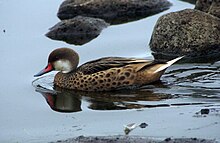|
White-cheeked pintail
The white-cheeked pintail (Anas bahamensis), also known as the Bahama pintail or summer duck, is a species of dabbling duck that is spottily distributed throughout South America and the Caribbean. It was first described by Carl Linnaeus in his landmark 1758 10th edition of Systema Naturae under its current scientific name. TaxonomyThe white-cheeked pintail was formally described in 1758 by the Swedish naturalist Carl Linnaeus in the tenth edition of his Systema Naturae under the current binomial name Anas bahamensis.[2][3] Linnaeus based his account on the "Ilathera duck" that had been described and illustrated by the English naturalist Mark Catesby in the first volume of his book The Natural History of Carolina, Florida and the Bahama Islands that was published between 1729 and 1732.[4][a] Three subspecies are recognised:[6]
DescriptionLike many southern ducks, the sexes are similar. It is mainly brown with white cheeks and a red-based grey bill (young birds lack the pink). It cannot be confused with any other duck in its range.[7] Distribution and habitatIt is found in the Caribbean, South America, and the Galápagos Islands. It occurs on waters with some salinity, such as brackish lakes, estuaries and mangrove swamps.[7] BehaviourThe white-cheeked pintail feeds on aquatic plants (such as Ruppia), grass seeds, algae[8][9] and small creatures (such as insects and small aquatic invertebrates)[8][9] obtained by dabbling. The nest is on the ground under vegetation and near water.[7] AvicultureIt is popular in wildfowl collections, and escapees are frequently seen in a semi-wild condition in Europe. A leucistic (whitish) variant is known in aviculture as the silver Bahama pintail.[10] Gallery
Notes
References
External linksWikimedia Commons has media related to Anas bahamensis. Wikispecies has information related to Anas bahamensis.
|
||||||||||||||||||||||||||||||||||||||
















